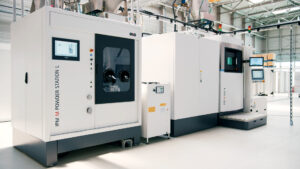The 3D printing process, also known as additive manufacturing (AM), continues to mature as a complementary or alternative process to conventional manufacturing techniques. The technology is described as additive because of the w ay in which the process involves the application of layer after layer of thin material, which is then hardened by an energy source. Along with plastics and ceramics, it is also possible to produce metal components in a 3D printing process.
ay in which the process involves the application of layer after layer of thin material, which is then hardened by an energy source. Along with plastics and ceramics, it is also possible to produce metal components in a 3D printing process.
The aim of the joint project between Premium AEROTEC, EOS and Daimler was to develop a digitalized next-generation manufacturing line which would be able to produce aluminum components for the automotive and aerospace sectors more cost-effectively than is currently possible. The outcome of NextGenAM showed manufacturing costs could be reduced by up to 50 percent compared with existing 3D printing systems.
“As far as the aircraft industry is concerned, Premium AEROTEC is today already an international pioneer in the field of metallic 3D printing. The aim now is to build further on this expertise and to bring it to bear in other sectors as well,” said Dr. Thomas Ehm, chairman of the Executive Board of Premium AEROTEC. “The successful conclusion of NextGenAM thus represents another important building block in our strategy.”
The entire production process runs itself, without operating personnel, from a central, autonomous control center. Fundamental to the system, EOS says, is the way all the machines used are networked. The build job data are transmitted to the control center, which then prioritizes the various build requests and allocates them to an AM system. During the build process, the manufacturing status can also be retrieved on a mobile device, independent of location. Once the full production chain has been completed, the quality reports are sent back centrally to the control center. All the data necessary for the production of a digital “twin” can be accessed here, so allowing complete traceability.
“We are very proud of what we have been able to achieve in collaboration with our partners Premium AEROTEC and Daimler. The NextGenAM project has provided a very tangible demonstration of how industrial 3D printing can be used cost-effectively in series production as part of an automated process chain,” Dr Adrian Keppler, CEO of EOS, says. “In combination with the possibilities for digitalization as used here, the pilot plant represents nothing less than a milestone along the way to digital manufacturing.”